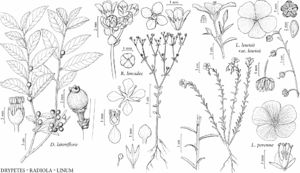Trees [shrubs], evergreen [deciduous], dioecious [rarely monoecious]. Leaves alternate [rarely opposite], simple; stipules present; petiole present; blade margins entire, dentate, or serrate; venation pinnate. Inflorescences unisexual, axillary [cauliflorous], fascicles or flowers solitary. Flowers unisexual; perianth hypogynous; hypanthium absent; sepals [3–]4–5[–7], distinct; petals 0; nectary present [absent]; stamens [2–]4–10[–50], distinct, free; anthers dehiscing by longitudinal slits; pistil 1, 1–2[–4]-carpellate; ovary superior, 1–2[–4]-locular, placentation axile; ovules 2 per locule, anatropous; styles [0]1–2[–4], distinct [connate basally]; stigmas 1–2[–4]; pistillode present [absent] in staminate flowers. Fruits drupes. Seeds 1 per locule or 1 per fruit by abortion.
Distribution
Fla., Mexico, West Indies, Central America, South America, Asia, Africa, Indian Ocean Islands, Pacific Islands, Australia, tropical and subtropical regions.
Discussion
Genera 2, species ca. 200 (1 genus, 2 species in the flora).
Putranjiva Wallich, with three or four species in tropical and subtropical Asia differs from Drypetes in lacking a nectary, usually having only two or three stamens, and having conspicuously dilated, petaloid stigmas. These two genera were long considered to belong to Euphorbiaceae subfam. Phyllanthoideae Kosteletzky. DNA sequence data demonstrate that they form a clade in Malpighiales separate from the rest of Euphorbiaceae and should be treated as a distinct family (Angiosperm Phylogeny Group 2003, 2009; K. Wurdack et al. 2004; T. Tokuoka and H. Tobe 2006; Wurdack and C. C. Davis 2009); their distinctness is also supported by embryology and seed anatomy (W. Stuppy 1996; Tokuoka and Tobe 1999, 2001). Molecular data support a sister-group relationship between Drypetes and Putranjiva. Sibangea Oliver, a genus of three tropical African species, is sometimes distinguished from Drypetes by its pistillate sepals not touching in bud and persisting in fruit (versus imbricate and deciduous in Drypetes); molecular data show it to be embedded within Drypetes (Wurdack et al.).
Members of Putranjivaceae generally produce glucosinolates (mustard oils), often giving the plants a characteristic odor. They are the only plants outside the Capparales known to produce these chemicals (J. Rodman et al. 1998).
Selected References
None.
